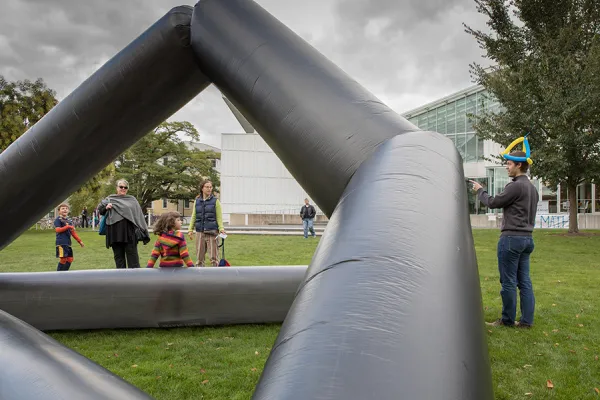A Day to Experience the ‘Cooler Aspects’ of Math
Research & Inquiry

Published October 26, 2018
“Does this look like math?” “No!” replied a gaggle of delighted kids gathered around Colm Mulcahy, a magician doing mathematical card tricks on a recent Saturday in the Campus Center.
Mulcahy’s tricks were just one of a series of “mathematical amusements and astonishments” offered during Smith’s first “Mad Math” field day on October 20.
The day was the brainchild of Jim Henle, Myra M. Sampson Professor Emeritus of Mathematics and Statistics. Inspired by a biannual math conference he has attended in Atlanta, Ga., Henle said he wanted to bring the spirit of people doing “cool math stuff” to Smith.
Central campus certainly felt like a field day—except with brain teasers and puzzles on display instead of tug-of-war contests and soccer games. Among the amusements were mathematical bell ringing, children pushing an icosidodecahedron around Seeyle Lawn and giant balloon sculptures–only one of which managed to escape the confines of its student handlers and float away into the crisp fall afternoon.
How many students does it take to build a 7-foot Soma Cube puzzle?
It turns out, only two. Math major Quincy Webb ’21 and religion major Halley Haruta ’20 had volunteered to create a large-scale version of the classic desktop puzzle.
The students were excited to show off a different side of math to Smithies—and the general public.
“A lot of people end up hating math because they never understand it, because it’s never taught in a way they can understand,” said Webb. “If people can see stuff like this–the cooler aspects of math–maybe they’ll be more interested.”
Many of the visitors to Mad Math already seemed on board with those aspects, arriving decked out in t-shirts that declared them to be “STEMINISTS.” Becca Tramel ’09, had brought her 11-month-old son, Rowan, who was sporting a math shirt adorned with formulas and equations.
During a math art tour led by Libby Keller ’20, young Lucca Fiorentino’s enthusiasm was infectious. The 7-year-old persuaded the adults around him to try their hands at creating an abstract art piece using calculations from a pair of dice.
With two dice, there was a 1-in-36 chance participants would roll a combination of one shape and one color, explained Keller, who is participating in the Smith College Museum of Art’s Student Museum Educator Program. Together, the group made a “masterpiece” filled with green triangles, purple rectangles and black patterns of five.
Prof. Henle said Smith’s first Mad Math day was held in honor of popular mathematics writer Martin Gardner, who inspired a generation of mathematicians—Henle included. Gardner helped change mathematics, Henle said, from a solitary occupation “to a collaborative, social enterprise.”
The day at Smith was nothing if not collaborative and social. And everywhere you looked, math was in the details: in the events, the student volunteers inspiring new learners, and in Henle himself, riding his bicycle wearing a balloon polyhedron hat in lieu of a helmet.
A giant balloon sculpture was just one of the displays offered at Smith's first Mad Math field day.